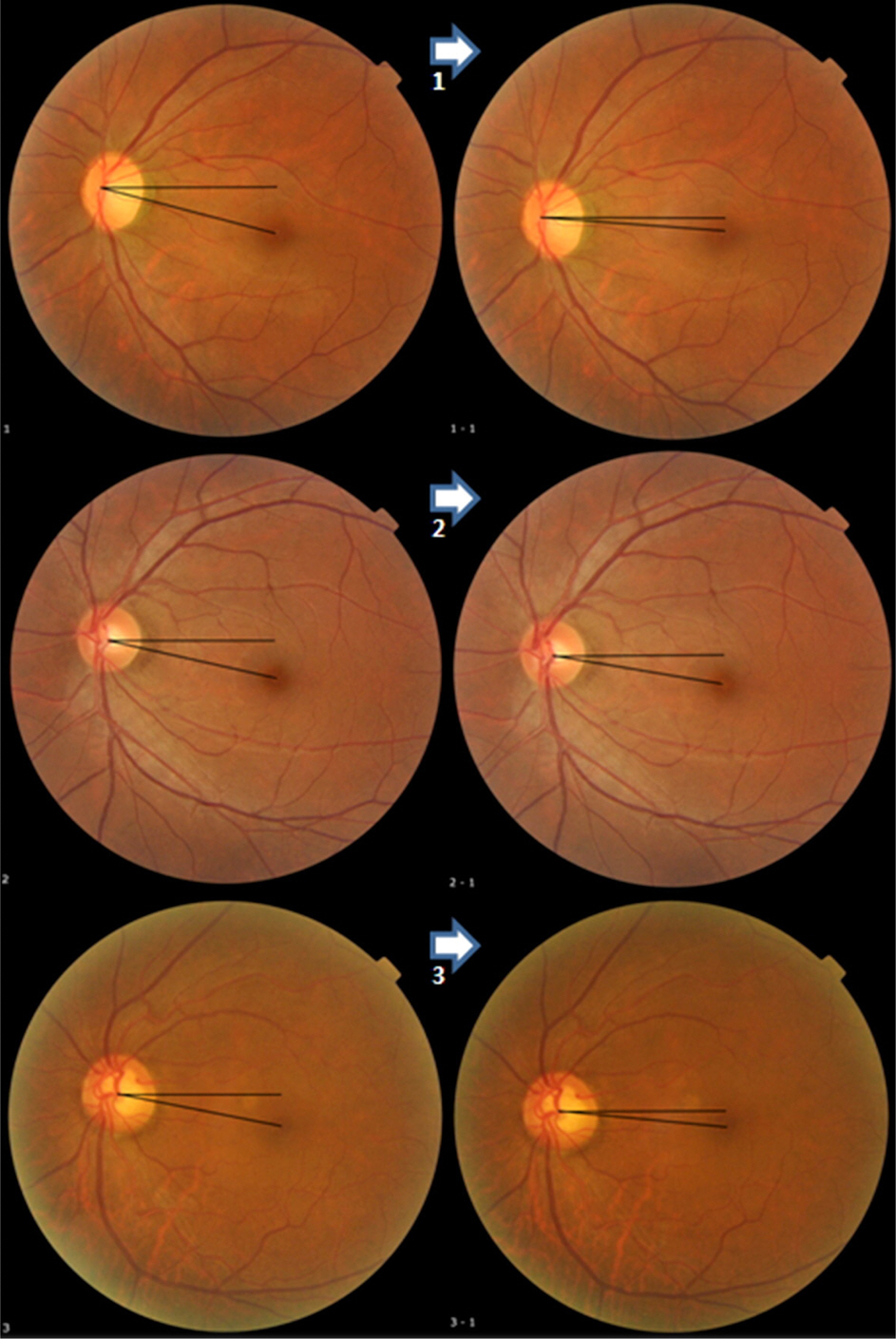J Korean Ophthalmol Soc.
2015 Feb;56(2):162-167. 10.3341/jkos.2015.56.2.162.
Comparison of Diplopia and Ocular Torsion Rate in Blow-Out Fracture Patients
- Affiliations
-
- 1Department of Ophthalmology, Kangdong Sacred Heart Hospital, Hallym University College of Medicine, Seoul, Korea. doctura@naver.com
- KMID: 2215997
- DOI: http://doi.org/10.3341/jkos.2015.56.2.162
Abstract
- PURPOSE
We compared ocular torsion rates in blow-out fracture patients before and after blowout fracture repair by analyzing mean disc foveal angles.
METHODS
The study participants were divided into 2 groups: blow-out fracutre repair patients (n = 36) and controls (n = 36). We measured ocular torsion rates by analyzing mean disc foveal angle. The angle was composed of 2 imaginary horizontal lines which crossed the optic disc center and fovea. We compared statistically ocular torsion rates in blow-out fracture patients based on subsided diplopia, continued diplopia, or absence of diplopia before and after blow-out fracture repair using paired t-test.
RESULTS
In the patient group, ocular torsion rates were statistically significantly decreased. In the blow-out fracture repair group with subsided diplopia, ocular torsion rates were decreased statistically from 7.74 +/- 3.48 degrees before blow-out fracture repair to 5.02 +/- 3.11 degrees after blow-out fracture repair. In the blow-out fracture repair group with continued diplopia or absence of diplopia before surgery, ocular torsion rates did not change statistically significantly from 6.36 +/- 2.80 degrees before blow-out fracture repair to 6.51 +/- 3.24 degrees after blow-out fracture repair.
CONCLUSIONS
Subsided diplopia after blow-out fracture repair and ocular torsion rate changes were significantly related in blow-out fracture patients. Further research which on the correlation of intraorbital change and movement of orbital position after blow-out fracture repair with ocular torsion rates are necessary.
MeSH Terms
Figure
Reference
-
References
1. Kim SK, Chang HK. The clinical study of treatment of blowout fracture. J Korean Ophthalmol Soc. 1995; 36:1629–35.2. Kim HE, Lew H, Yun YS. The size of extraocular muscles estimated by computed tomography in patients undergoing orbital wall fracture repair. J Korean Ophthalmol Soc. 2009; 50:1447–54.
Article3. Poeschl PW, Baumann A, Dorner G. . Functional outcome after surgical treatment of orbital floor fractures. Clin Oral Investig. 2012; 16:1297–303.
Article4. Thiagarajah C, Kersten RC. Medial wall fracture: an update. Craniomaxillofac Trauma Reconstr. 2009; 2:135–9.
Article5. Hwang JH, Kwak MS. Residual Diplopia and Enophthalmos after Reconstruction of Orbital Wall Fractures. J Korean Ophthalmol Soc. 2003; 44:1959–65.6. Cha MB, Min BM, Choi SH. Analysis of ocular motility disturbance remained after open reduction in orbital wall fracture. J Korean Ophthalmol Soc. 1997; 38:1885–91.7. Ceylan OM, Uysal Y, Mutlu FM. . Management of diplopia in patients with blowout fractures. Indian J Ophthalmol. 2011; 59:461–4.
Article8. Joseph JM, Glavas IP. Orbital fractures: a review. Clinical Ophthalmol. 2011; 5:95.
Article9. Kim HW, Kim YI, Won IK. Clinical analysis of blowout fracture with ocualr motion limitation: comparison of surgical and conservative treatment. J Korean Ophthalmol Soc. 1999; 40:632–8.10. Kushner BJ, Hariharan L. Observations about objective and subjective ocular torsion. Ophthalmology. 2009; 116:2001–10.
Article11. Lee HJ, Lim KH. The range of ocular torsion in mass screening. J Korean Ophthalmol Soc. 2005; 46:1684–9.12. Kothari MT, Venkatesan G, Shah JP. . Can ocular torsion be measured using the slitlamp biomicroscope? Indian J Ophthalmol. 2005; 53:43–7.
Article13. Kim EH, Lee SJ, Choi HY. Ocular torsion according to fixation in fundus photograph. J Korean Ophthalmol Soc. 2006; 47:449–54.14. Bixenman WW, von Noorden GK. Apparent foveal displacement in normal subjects and in cyclotropia. Ophthalmology. 1982; 89:58–62.
Article15. Park KH, Shin JH, Kim SY. Surgical results of modified Harada-Ito operation for excyclotorsion. J Korean Ophthalmol Soc. 2012; 53:565–71.
Article16. Kang HJ, Ha MS. A clinical feature of the patients of orbital wall fracture with diplopia. J Korean Ophthalmol Soc. 2009; 50:969–75.
Article17. Pearl RM. Treatment of enophthalmos. Clin Plast Surg. 1992; 19:99–111.
Article18. Iliff NT. The ophthalmic implications of the correction of late enophthalmos following severe midfacial trauma. Trans Am Ophthalmol Soc. 1991; 89:477–548.19. Converse JM, Smith B, Obear MF, Wood-Smith D. Orbital blow-out fractures: a ten-year survey. Plast Reconstr Surg. 1967; 39:20–36.20. Burres SA, Cohn AM, Mathog RH. Repair of orbital blowout fractures with Marlex mesh and Gelfilm. Laryngoscope. 1981; 91:1881–6.
Article21. Lee SJ, Park KS. Relationship between preoperative clinical features and postoperative recovery of ocular motility restriction in blow-out fractures. J Korean Ophthalmol Soc. 2001; 42:1202–9.
- Full Text Links
- Actions
-
Cited
- CITED
-
- Close
- Share
- Similar articles
-
- Relationship between Preoperative Clinical Features and Postoperative Recovery of Ocular Motility Restriction in Blow-out Fractures
- Prognosis and Clinical Features of Orbital Wall Fracture in Preschool Children
- Radiologic Study of Torsion Type of Supracondylar Fracture of Humerus in Children
- Alternative Use of Inferior Blow-out Fracture Reduction with Urinary Balloon Catheter
- A Clinical Study of Pediatric Orbital Wall Fracture



